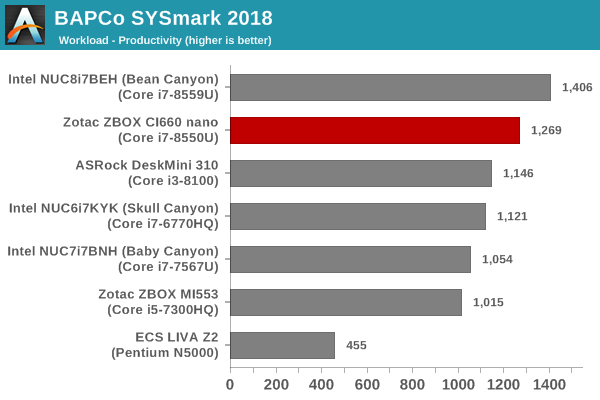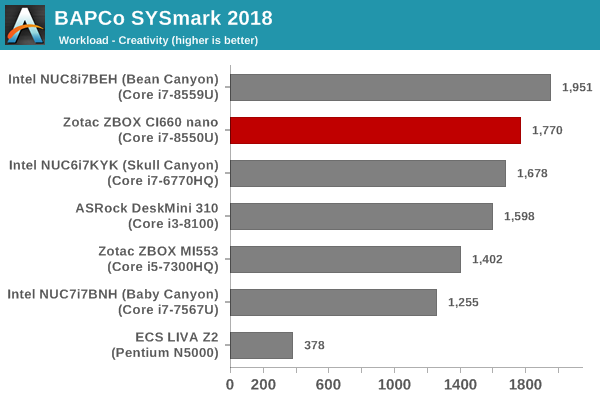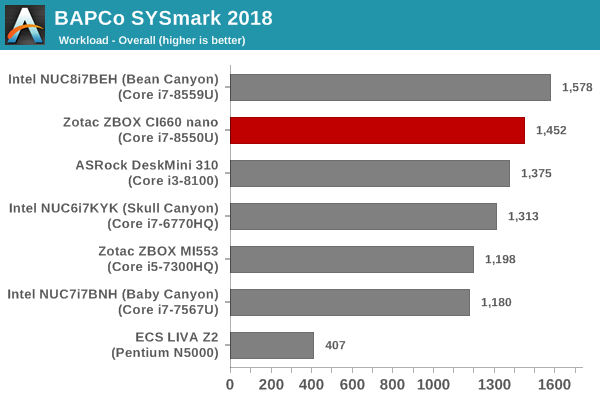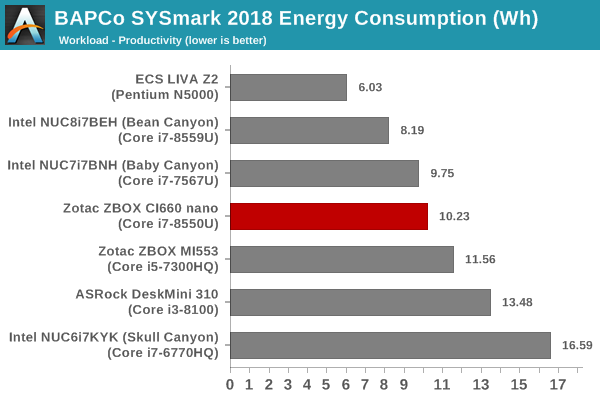The Zotac ZBOX CI660 nano Fanless mini-PC Review: A Promising HTPC Platform
by Ganesh T S on April 16, 2019 8:15 AM ESTBAPCo SYSmark 2018
The Zotac ZBOX CI660 nano was evaluated using our Fall 2018 test suite for small-form factor PCs. In the first section, we will be looking at SYSmark 2018.
BAPCo's SYSmark 2018 is an application-based benchmark that uses real-world applications to replay usage patterns of business users in the areas of productivity, creativity, and responsiveness. The 'Productivity Scenario' covers office-centric activities including word processing, spreadsheet usage, financial analysis, software development, application installation, file compression, and e-mail management. The 'Creativity Scenario' represents media-centric activities such as digital photo processing, AI and ML for face recognition in photos and videos for the purpose of content creation, etc. The 'Responsiveness Scenario' evaluates the ability of the system to react in a quick manner to user inputs in areas such as application and file launches, web browsing, and multi-tasking.
Scores are meant to be compared against a reference desktop (the SYSmark 2018 calibration system, a Dell Optiplex 5050 tower with a Core i3-7100 and 4GB of DDR4-2133 memory to go with a 128GB M.2 SATA III SSD). The calibration system scores 1000 in each of the scenarios. A score of, say, 2000, would imply that the system under test is twice as fast as the reference system.




SYSmark 2018 also adds energy measurement to the mix. A high score in the SYSmark benchmarks might be nice to have, but, potential customers also need to determine the balance between power consumption and the efficiency of the system. For example, in the average office scenario, it might not be worth purchasing a noisy and power-hungry PC just because it ends up with a 2000 score in the SYSmark 2014 SE benchmarks. In order to provide a balanced perspective, SYSmark 2018 also allows vendors and decision makers to track the energy consumption during each workload. In the graphs below, we find the total energy consumed by the PC under test for a single iteration of each SYSmark 2018 workload. For reference, the calibration system consumes 5.36 Wh for productivity, 7.71 Wh for creativity, 5.61 Wh for responsiveness, and 18.68 Wh overall.




Despite being a dimunitive machine compared to the reference desktop, the ZBOX CI660 nano manages impressive scores across all the workloads due to its quad-core processor. In terms of raw performance and performance per watt, it is only surpassed by the Core i7-based Bean Canyon NUC (NUC8i7BEH). The energy consumption numbers are a bit high, considering that there is no active cooling. However, the performance numbers more than make up for it.










23 Comments
View All Comments
eastcoast_pete - Tuesday, April 16, 2019 - link
Thanks Ganesh! Two comments, one question - question first:Was your choice of a SATA SSD based on the ability of the ZBOX to support (not support) an NVMe SSD, or based on what parts were available?
As a comment, use of slower vs. faster storage (SATA vs NVMe) will obviously affect a number of performance benchmarks. Why not standardize on one unless the unit tested won't support the better option?
My other comment is about the pricing of the ZBOX (bare bone): not a good value proposition for HTPC use, given that the current i7 NUC is cheaper, with a superior CPU/GPU. The presence of two gigabit ethernet connections in the ZBOX might be a plus in certain situations, but otherwise it's overpriced compared to the NUC.
ganeshts - Wednesday, April 17, 2019 - link
No NVMe SSD support in the CI660 nano. I had to use a SATA drive, and chose the best one available at my disposal from a cost viewpoint (at the time I configured the review sample - sometime in early Q4 2018).You are right about standardizing the storage drive. However, we tend to choose a drive available in retail for a reasonable cost at the time of configuring the review sample. Since we review a system or two each quarter, it becomes difficult to use the same drive across a large number of reviews. That said, you can find that we either use Crucial SATA SSDs (MX200 / BX300) or Samsung / WD NVMe SSDs (950 PRO / WD Black / SanDisk Extreme Pro) unless the sample comes pre-configured with different SSDs by the vendor (eg. - Hades Canyon).
The CI6xx nano platform is suitable for HTPCs, though, the i7 model might be a bit too pricey for that sole purpose. As one of the other commentators noted, Zotac does have i3- and i5- models in the series.
mooninite - Tuesday, April 16, 2019 - link
$865 is $300 too much. Looks like most of this cost is tied up with the use of an i7, which is completely unnecessary in this form factor. CPU power is not the limitation here. The GPU is.I can't see this as a big seller over a NUC.
mooninite - Tuesday, April 16, 2019 - link
Also, I wish Zotac had come out with their AMD mini-pcs with Vega graphics. Such a shame... that would have sold. I wonder why they backed out.Haawser - Wednesday, April 17, 2019 - link
Agreed, I'd rather have a 15W Ryzen 7 3700U in this form factor. Because UHD620 is going to be a severe limitation for anything beyond the most basic low res, minimum settings gaming. Whereas at 720p/med fullscreen, Vega 10 should play pretty much anything.No idea why Zotac don't offer a Ryzen APU version. Intel 'discounts' maybe ? Or rather, threats of removing them if Zotac don't play ball ? Wouldn't put it past them to offer 'inducemets' like that. Their history being what it is.
lukethedrifter - Tuesday, April 16, 2019 - link
There are i3 and i5 versions as well, ci620 and ci640 respectively.This is a niche product for those who want something NUC-sized but fanless, for which there are relatively few options.That's the selling point, not that it's price competitive with regular NUCs.
Beaver M. - Monday, April 29, 2019 - link
Or an Nvidia Shield, which is still the best and cheapest way to get what an HTPC is supposed to do.mikato - Tuesday, April 16, 2019 - link
Noise question here... Ganesh, you said you were disappointed in the fan noise of the Intel NUC8i7BEH though I didn't see much detail. How bad was it (idle and when streaming something), and is this ZBOX far better noise-wise because it's fanless?ganeshts - Wednesday, April 17, 2019 - link
The Bean Canyon NUC's fan is problematic because it is small and high-pitched when there is sudden load on the CPU. At idle, not that much. But, network streaming and even Kodi playback sometimes makes the unit hot enough for the fan to turn on. It is audible from 10 ft away, particularly during quiet scenes in the movie. The ZBOX noise is inaudible at that range - so, for the HTPC user who isn't very picky, it might work.That said, there are some passive chasses for the Bean Canyon NUCs in the market. Those might be worth a look. However, that is not a 'ready-out-of-the-box' solution.
mikato - Friday, May 3, 2019 - link
Thanks! Please keep include noise as a concern in these mini PCs.